No products in the cart.
Hodaka Combat Wombat, motorcycle restoration
Restoration Project: Hodaka “Combat Wombat”
Posted on by David Russell
Part 1
We thought it might be fun to (finally) document a motorcycle restoration. While I’ve done quite a few restorations, mostly of vintage dirt bikes, I’ve never recorded the process. And, while I’m certainly not The Expert in this work, we can always learn from one another’s experiences. (And since the best-selling Vintage Motor Tee may actually be the Combat Wombat design—and a good Combat came our way, recently—we decided this might be a good match.)
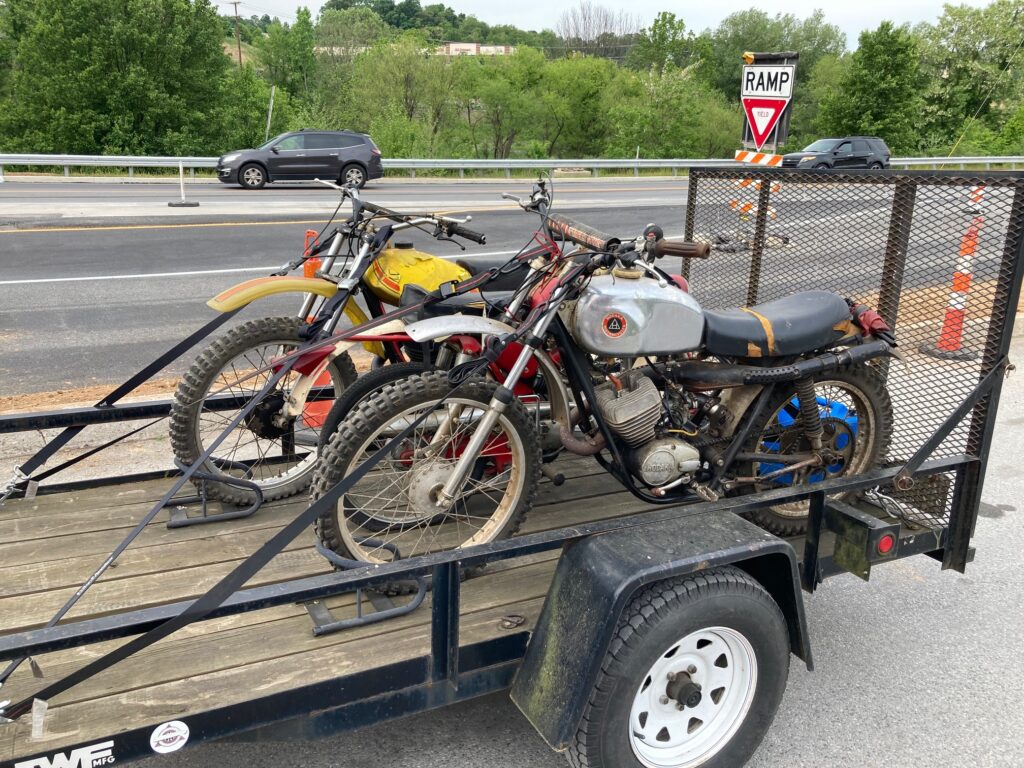
“Please take me home! I promise I’ll be good and not makes messes! (Got any gas?)”
Entering the Combat Zone
Christian and I recently bought several old motorcycles from an estate sale in south-central Pennsylvania, to include a 1975 OSSA Super Pioneer, a mid-1960s Allstate/Puch 60cc street bike, and the Hodaka. For anyone who isn’t familiar with Hodaka, one might describe the line as the “built in Japan, but designed in America” marque, part of the great motorcycle sales era of the 1960s and 1970s. Hodaka was characterized initially by the motorcycling press as the “good” trail bike from Japan. And they certainly seemed to be: Hodakas were reliable, simple, well-designed, eclectic (as we’ll see), and only slightly more expensive then their Big Four Japanese cousins. They benefitted from an American importing and design team (the Pacific Basin Trading Company—PABATCO, based in Athena, Oregon) who were actual motorcycle enthusiasts, and apparently possessed a much better idea of what North American riders wanted and needed than did distant engineers (to include those working for the Big Four in Japan). Hodakas incorporated competition-proven frame geometry, while at the same time attending to required street-legal equipment—though with minimalist (lighter weight) treatment. Built from 1964 through PABATCO’s demise in 1977, Hodakas were loved, at least initially, by the press and the riding public—possibly for relating to buyers as riders rather than simply customers—and filled a role in motorcycling not unlike American Motors Corporation in the automotive world: a small energetic competitor nipping at the heels of a sometimes deaf and monolithic establishment. Like AMC and its cars, Hodaka built relatively inexpensive and good (and, sometimes very good) bikes which gave excellent value, seemed to be made with FUN baked in, and were different (with unusual model names like Super Rat, Wombat, Road Toad, etc.). One couldn’t hate a Hodaka any more than one could dislike Lionel trains, baby bunnies, Roy Rogers, or watching cartoons on a Saturday morning.
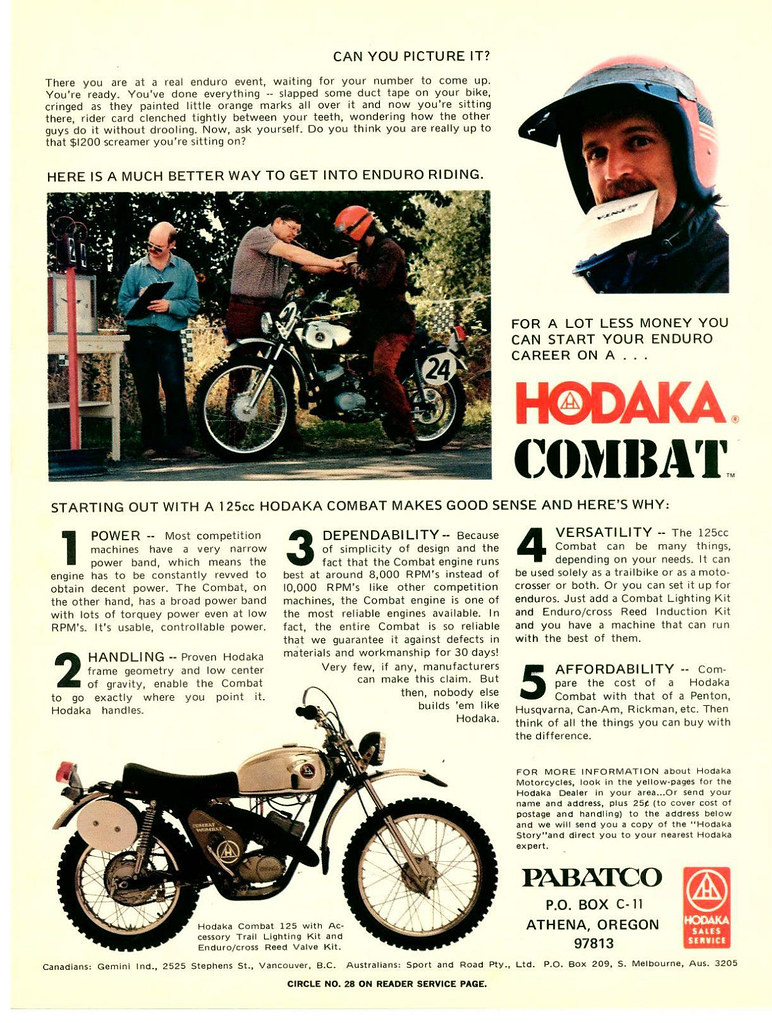
Hodaka ad from 1973. Hodaka built the case for the Combat in this ad campaign by incorporating a classic American Who-do-you think-you-are?/Don’t-get-too-
Hodakas were widely used in competition in North America, and production models were largely the result of race testing and breeding by the American PABATCO staff. The company actively courted an image in period advertising as the affordable, reliable, perfectly acceptable alternative to the then-dominant European purebreds. What your Hodaka might concede in top horsepower or a few less pounds to the exotics, the company’s ads seemed to say, your trusty Hodaka would more than make up in reliability and value. This was a bike whose economy your mother would approve of. The Hodaka didn’t pretend to be an expensive, high-strung Penton, Sachs, Maico or Husqvarna—and it didn’t want to be one. The 90cc and 100cc Hodakas were extremely popular in North American scrambles racing and general trail riding, from the late Sixties, on. Enduro competition was a stable of American sport motorcycle culture already, and the company’s machines fit that use, as well. The 125cc Wombat was released as a trail bike/endure bike in 1972, to positive press and public reception. Seeing motocross expanding in America in the early Seventies, the company responded by releasing its competition variant of the Wombat—the Combat Wombat—in 1973. The Combat was a good motorcycle; unfortunately for PABATCO and every other manufacturer of small bore dirt bikes that year, the release of Honda’s CR-125 Elsinore model introduced an outstanding motorcycle to the public, immediately surpassing every other 125cc competition motorcycle, in one way or another. Hodaka responded with the Super Combat in 1974—noted to be the quickest-in-a-drag-race production 125 made that year—but by then the field was filled with even more excellent bikes at reasonable prices, such as Suzuki’s TM-125 and Kawasaki’s KX-125. Thus, the Combat Wombat was a one-year offering; total production was about 8000 units, with the bulk coming to the US. Most were probably used as play-bikes, and examples are not uncommon, today.
(For the complete history of Hodaka, see Ken Smith’s beautiful Hodaka Motorcycles: The Complete Story of America’s Favorite Trail Bike.)
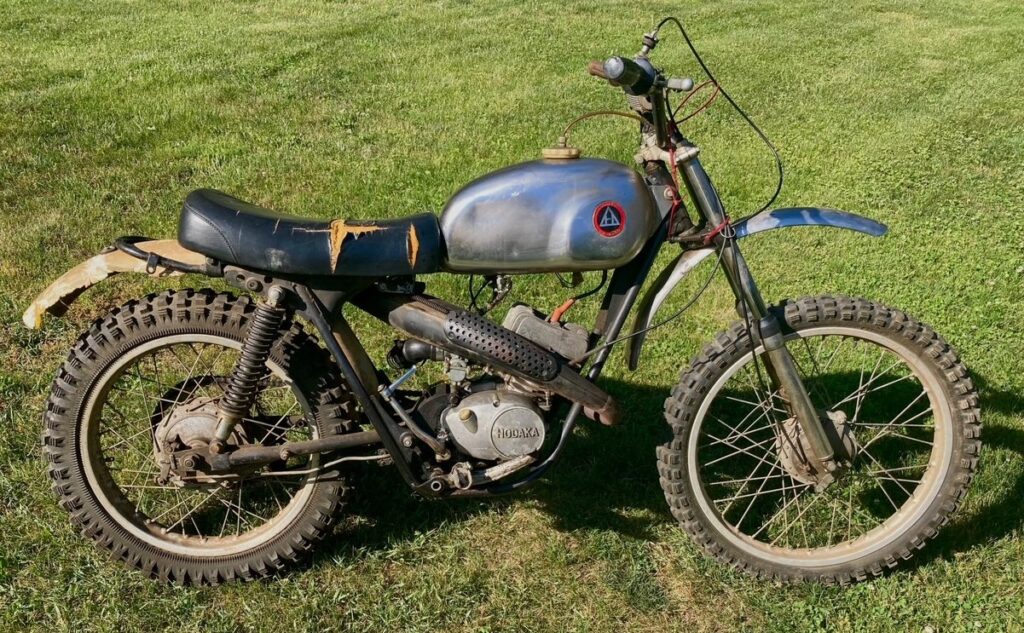
Seeing what we got. Fenders, seat, missing air-box—bad. Engine, wheels, and intact pipe—good!
Will you take me home?
Our Combat was a surprise on several counts. Being informed by a good friend that a local family was selling their father’s estate—and that the collection included several older motorcycles—my son and I naturally over-estimated the opportunity, as old-bike buyers are prone to do. Informed that among the bikes was a “Hodaka Wombat with a perfect gas tank,” I naturally fantasized about a ‘cream puff’ example in near-perfect condition. The valuation by an independent estimator of $900 seemed likewise to portray a very clean example (though perhaps a bit low in price), as did the professional status of the prior owner.
Reality does bite. Or at least gives you a pinch. In the fair light of the open garage bay, I noted rather quickly that this was either a Wombat stripped for off-road work, or, more probably, a Combat Wombat. A quick look at images on the indispensable smartphone by Christian confirmed the Combat identification. The bike was in generally intact condition—with the iconic olive drab air-cleaner missing, the seat (and foam…drat) torn, metal fenders damaged or missing, and overall a bit tatty & oily (the latter often a positive condition). On the positive side were an equally strong list of attributes.
When I consider the value and/or suitability for restoration of an old motorcycle, I tend to go through a mental checklist which includes all subgroups of the motorcycle’s condition. Doing so is important, I’ve learned, in avoiding paying too much or getting oneself into a project over one’s head in terms of expense or time. Let’s use the Combat as an example to illustrate this process. In no set order, I consider the following areas and criteria:
Bodywork. Optimally, paint and chrome/metal-work will not only be present, but in a condition inviting cleaning and preservation, vice actual restoration (i.e., painting or re-plating). Here the Combat is lacking. Besides the missing painted & lettered air-box (arguably the iconic crowning glory of the motorcycle), the front steel fender is deformed and may not be correct, and the rear fender is AWOL. A quick search on the web shows that repro fenders for at least some Hodakas are available, but at about $200 each they will quickly increase the cost of restoration. Initial score: Reality-1, Combat-0.
Gas tank. I tend to evaluate gas tank condition separately from the rest of the bodywork, as dealing with them can be an adventure in and of itself. The tank on the Combat is… “pretty good.” Bringing me to this diagnosis are the following observations:
*It’s a chrome tank, with very light surface corrosion. While it won’t polish-out like a brand-new item, the look will be, hopefully…OK.
*There’s no rust inside the tank. Rust (and gunk) inside tanks is more important than we often first consider, in the carefree young love of another old bike purchase. (I recently learned this in due measure after investing about $100 and 30 man-hours into a vintage Yamaha tank. It was near-perfect on the outside, and thus needed saving. And, the inside didn’t look that bad, I initially thought…!) While techniques and products exist that will address rust, each rusty tank can be different. Sometimes products work exactly as advertised, and other times you may have to endure multiple treatments, weeks of soaking in solvent, and unplanned do-overs (i.e., clogged fuel delivery). In the worst cases, pinholes in the bottom can defy reasonable repair costs and time. So–please understand that a tank’s inside may be nearly as important as the exterior.
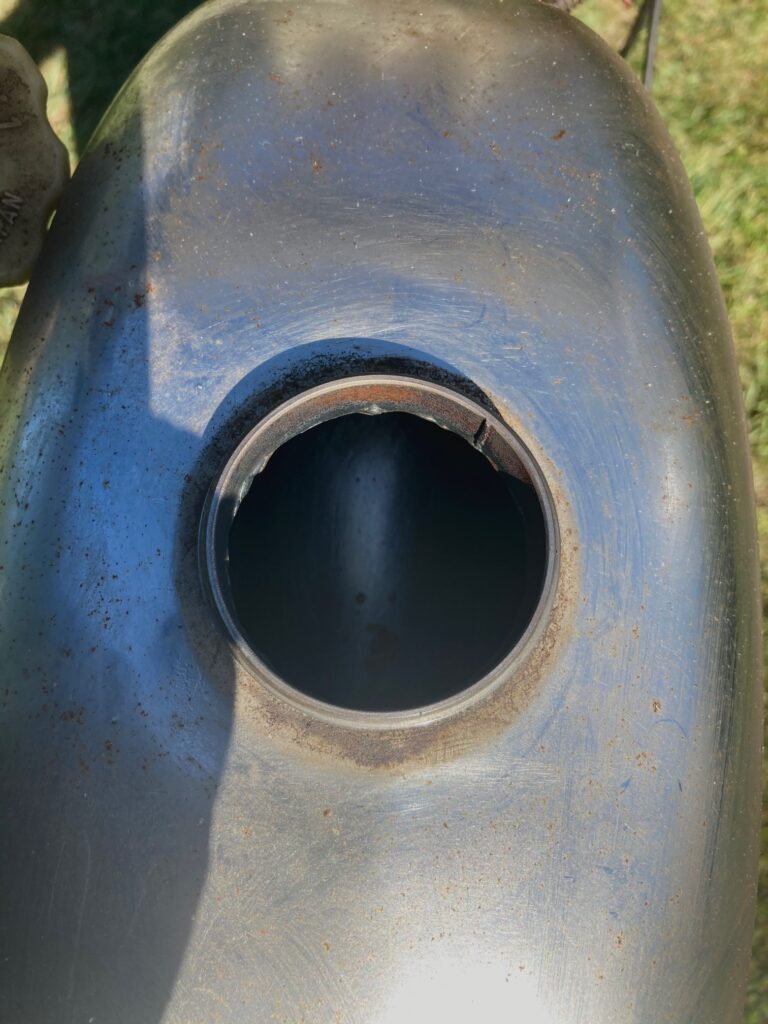
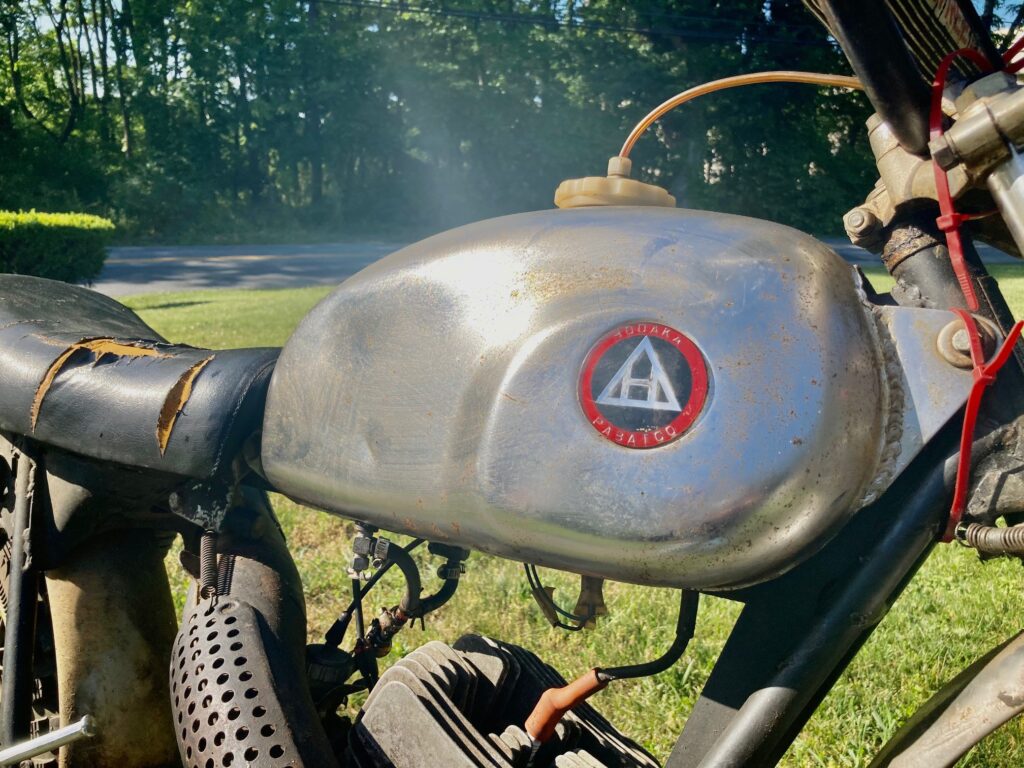
The good and bad: no rust inside, and exterior chrome finish just capable (maybe) of being polished. But then, in the sunlight, those two little dents appeared. Can they be easily popped out? Maybe.
*The tank is minimally dented. Very small tank dents may not matter at all for a machine that is to be a “rider,” and can be corrected (by skilled metal-workers) on bikes that need to look show quality. Dents on flat spots are of course easier to repair than those on edges/corners. Given all these findings, the Combat’s tank remains ‘on the edge,’ in terms of being acceptable or requiring replacement. Because I tend to restore to high level of finish—for both aesthetic enjoyment, now, and future re-sell reasons—I may be looking at finding a very good used or a new tank. (A note on non-metal tanks: With the Hodaka’s tank being steel, the cracking or structural damage associated with fiberglass, and the fading prevalent on old plastic, aren’t relevant in the Combat’s case. However, assessing these criteria is important with bikes that do have ‘glass or plastic tanks. For example, the old OSSA we purchased the same day has a non-repairable, ruined fiberglass tank. A reproduction tank for this bike runs $400, before paint—which would cost $200 to $500 if done by a pro—and decals ($75). So, tank condition is important!)
Spark. If you can kick the bike over and it produces spark, that’s good. Not getting spark on a grounded plug doesn’t necessarily mean you’ll need major repairs or parts…but having that beautiful little blue arc is a very probable sign you won’t need these. Lack of spark could, and often is, just a loose wire, a grounded kill switch, or some crud on the points; but it could be something more involved and expensive. Pulling the plug and pushing the kicker through a few strokes in the garage, our Combat has a hot blue spark—good boy!
Suspension. Again, several things to consider, here. I focus on:
*Are the fork tubes rusty (or bent)? Chroming a single fork tube, in my area, runs $225. So, fork condition is a factor. While rust above the swept area—that lower area which interacts with the fork seals and external rubber wipers—isn’t a problem with respect to performance, it’s still less-than-attractive and will affect resale value. (This is a particularly common challenge for Maico restorers like myself, the original German fork tubes being essentially raw steel and very prone to corrosion.) Thus, any rust spots/pinholes on the tubes should be considered before purchase, and in restoration planning. Aside from any especially grievous damage to the lower forks (the “sliders,” usually aluminum, but chromed steel in the case of Hodakas), I don’t worry much about other fork components. Vintage forks are easily rebuild-able, and seals and fasteners are always available. Our Combat’s fork tube and sliders are both in fairly good external condition—a definite positive!
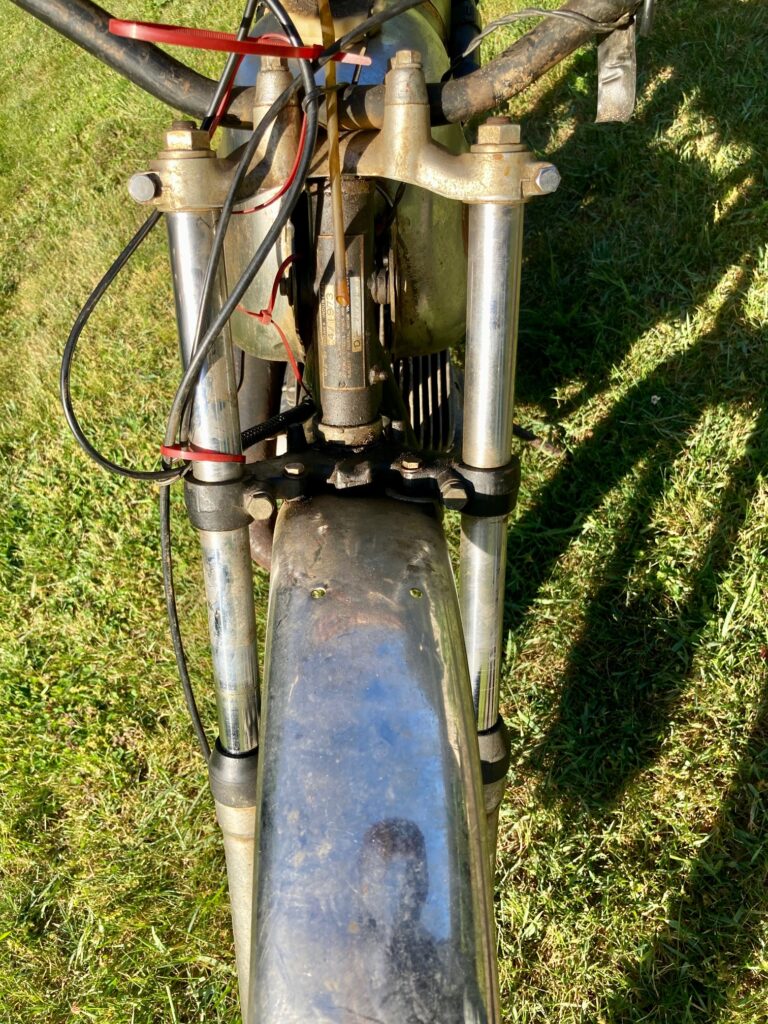
Fortunately, the fork tubes and the sliders (lower sections) are both basically rust-free. With chroming prices where they are—a result mostly of hyper EPA restrictions on metal refinishers—having just a set of tubes re-chromed will run about $450, in our area. On further examination, the front fender is original, and looks to be salvageable.
*Shock condition. If you’re not going to re-use the shocks, then their condition doesn’t matter. If you are planning to retain them—and, in the case of the Combat, I’d like to keep things original—then look at the shafts for rust and the bodies for obvious damage. You may be able to get a sense of any remaining damping by compressing them (pushing down on the seat and watching rebound), but…really…does damping matter in your situation? I say this because if the bike is going to be on static display, shock functioning is irrelevant. And, if you do plan to ride or race the [nearly 50 year old dirt] bike, you’ll likely want to replace the relics currently binding the frame to the swing-arm with something that actually works. Thus, don’t sweat the shocks, beyond shaft condition and only if you’re looking for originality. Shock bodies, springs and retaining hardware can all be reconditioned.
*Swing-arm (and rear sub-frame) condition. When “forward-mounting” and “long-travel” became The Thing in off-road riding, circa 1973, everyone seemed to be engaging a friend with a welder to move shocks up or lay them down. (Note: you normally won’t encounter forward-mounting on street bikes, or any other frame modifications, unless it was drag raced or used as a hill climber.) If your prospective motorcycle is thus modified, such a condition will generally be a detriment to overall value—especially if the work was amateurish. In the case of the Combat, it appears to have been pushed aside when long-travel hit, and is pleasingly pristine in its original 4 inch travel condition. Again—good!
Frame. A bent frame can be hard to identify. Thankfully, such a condition is fairly rare…though I did encounter it on a Bultaco recently. More common will be broken or rusted-through frame rails (often below the engine). Our Combat looks un-molested and sturdy.
Rims/spokes/hubs. For the most part, wheel hubs are rather indestructible (unless you’re a vintage Husky owner or perhaps a late 70s Maico racer), and the hubs on the Combat passed external inspection accordingly. Spokes—in my opinion—are nearly a disposable item. Most of the time (with Spanish bikes being the notable exception), spokes and/or nipples will be at least rusted, corroded or discolored…and at worst, frozen together. Re-spoking wheels yourself is not too expensive (spoke/nipple sets will run $40 to $110 per wheel), is enjoyable, and will result in a wheel that is both better looking and safer than what’s gently decomposing on there, now. Rims rate close attention. Although lacing up an expensive set of Excel rims ($170 to $230 per wheel) is currently de riguer, you may still prefer to stay original. Thus, you may want DIDs on your vintage Kawasaki KX, ridged Akronts on your vintage Euro bike, or—as is the case with our Combat—Takasagos. No doubt replacement Takasagos can be had, but I’d rather be able to use the OEM items on the bike, if at all possible, for a variety of reasons. And, happily, the rims are excellent and we can do this with the Combat!
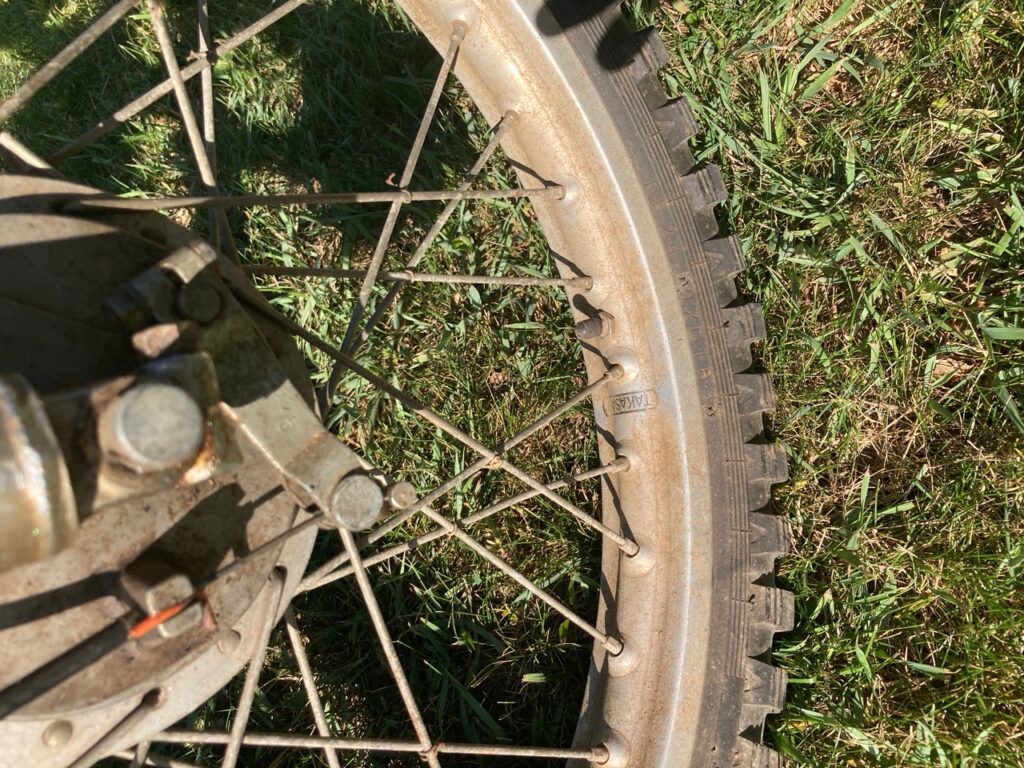
A “money shot,” depending on how much one wants to invest in a restoration. The rims are original and in excellent condition, and even the spokes are reasonably corrosion-free. (We’ll probably opt for spoke replacement, as the low purchase investment vs. the immense improvement in looks will be self-evident.) Going the high-end route on wheels (modern Excel rims/Buchanan spokes/having somebody else do the work) could easily bump a restoration like this up by $800 or more.
Engine. Engines are one of the places where financial black holes can develop. Or, to quote the wizards of the original DIRT BIKE Magazine, it’s where “cubic dollars” can be involved. Honestly, even big-bucks guys, planning on rebuilding an engine completely, would rather find a good engine than one needing everything, right? Now, if you plan to race a 45-year-old motorcycle, you’ll probably want to have the engine gone through carefully…but it doesn’t hurt to start with cases that don’t need welded, a non-locked-up rod and transmission, a clutch that functions, etc. Personally, I do not regularly run most of my collector motorcycles. Even so, it doesn’t mean I’m satisfied with hollow cases or locked-up lumps of steel and aluminum, either. Besides the nagging “unfinished” feeling this gives me, I also realize that a superficially-restored motorcycle like this will be worth far less, someday, when it’s sold. Ultimately, I suppose disguising a junk engine clashes with an enthusiast’s (and likely craftsman’s) desire to “do the job, right” at a most basic level.

Another (potential) good news story is the engine. Our hunch is that it will run, and the cases are damage-free. The pipe is likewise in relatively pristine condition—for a dirt bike—and the replacement air-box has already been located.
Thus, assuming that we’re generally in agreement with wanting an engine to be at least potentially able to run, there are several external checks we can make. Having already checked for spark, I’ll run the bike through the following pre-purchase examination:
*Does it turn over (i.e., are the internals of the engine free to move)? Using the kick-starter (or, lacking one, putting the bike in gear and using the chain to turn the countershaft sprocket), see if the engine is free. And, if it is free, does it feel/sound healthy, or does it give the impression of a box of rocks? If it isn’t free, attempt to determine whether it’s the piston/rod/crank, or the transmission that’s bound up. (Note: In my experience, the lack of the means to check for a free-wheeling engine—that is, no kick-starter and a missing chain—may suggest that someone was or is trying to hide a locked-up engine.)
*Does the transmission shift through the gears? Using the shift lever, find neutral and perhaps helping things by rocking the motorcycle back and forth a bit, attempt to go through all the gears.
*What is the condition of the oil (and by inference, the transmission components)? Using the dip stick or a thin wire or stick, check the oil in the cases. Is there any? Does it appear clean, or burnt? Is there any indication of water inside? If possible, look down the filler hole and note if you see gleaming, un-corroded steel…or rust and worn gears.
*What is the external condition of the engine? Are cooling fins bent or knocked out? Is there damage to the cases, caused by a thrown chain? Check the condition of the engine mount locations (where the cases connect to the frame)—where loose bolts can cause cases to be ground away. While a broken fin won’t affect the performance of an engine, now, it may mean very much to a future collector, when you seek to sell your bike.
Ultimately, all these observations are critical if you wish to avoid unnecessary expense, later. Bear in mind that it’s not just expense—though at $50 to $100 per gear, $200 for rod kits, and $150+ for piston kits, this can add up quickly. Another benefit of beginning with a good donor engine is that some replacement parts (especially gears) may not be readily available, for any price (my friends with early-1980s Honda CR480s will concur). And, again, we should understand that ust because an engine turns over and shifts is no guarantee that it doesn’t need parts or a teardown; the chances are that it will need work if you plan to ride it…often a top-end rebuild, carb re-freshening, clutch rebuild…and maybe a connecting rod/crank rebuild. Still, the more of these checks your potential new bike passes, the greater the chance of salvageable pieces and less headaches, during such a future rebuild.
Finally…the other little stuff. Take a look over the bike, at “the little things.” Are the levers correct for the model, and are they restorable? Is the kill switch original? If it had lights, are the [perhaps hard-to-source] switches present? Are the number plates original? What about the seat—it will nearly always need a replacement seat cover, but what about the foam? Is the seat pan rusted out? And, are there any aftermarket enhancements that actually increase the bike’s value (e.g., FoxShox, Simons forks, enduro route holders, aluminum handlebars, etc.). Now is also the time to ask the owners, “Does anything else come with the bike?” It may be that there are manuals, extra parts or a title that they simply didn’t remember or consider. Or, maybe there’s something else they want to get rid of. (I once travelled to buy an old Kawasaki. After we’d made the deal, the seller asked, “I don’t suppose you’d be interested in this antique mini-cycle that my boys had, in back of the shed, would you?” Why, yes, I was!)
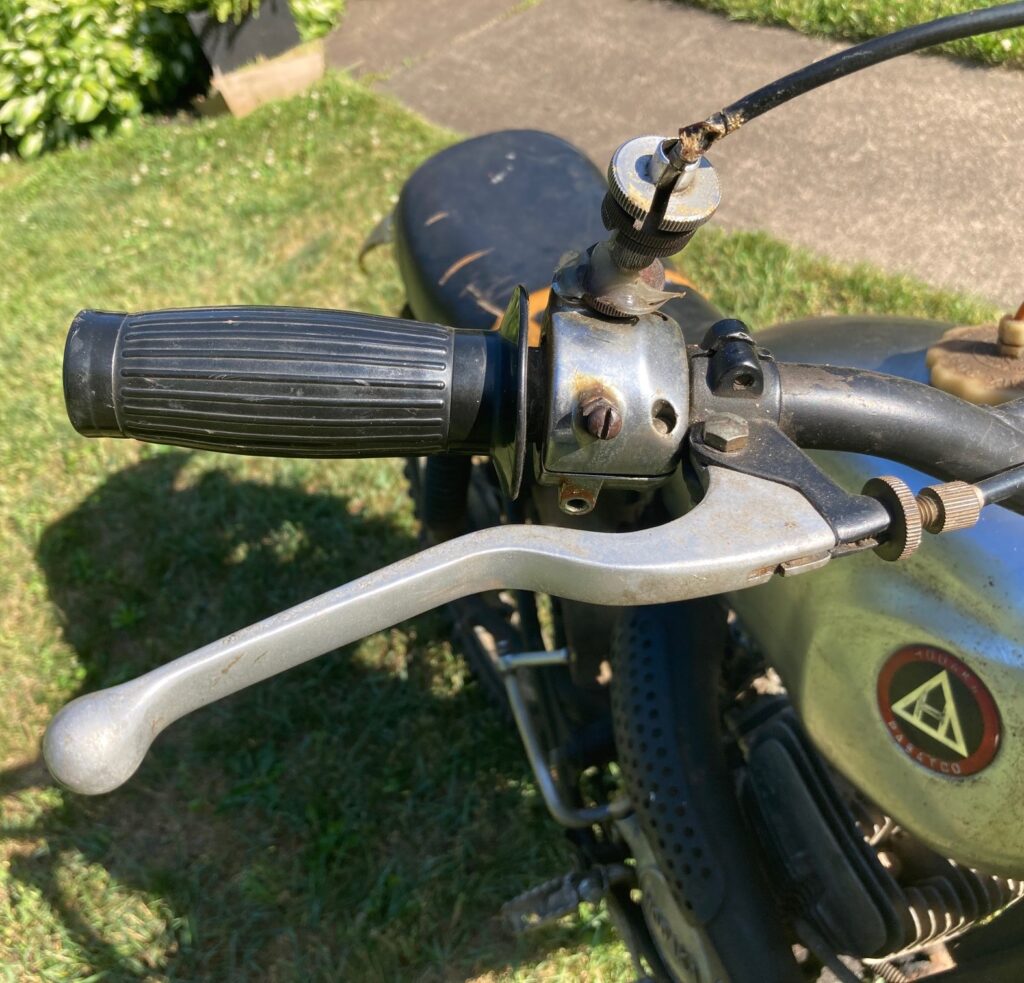
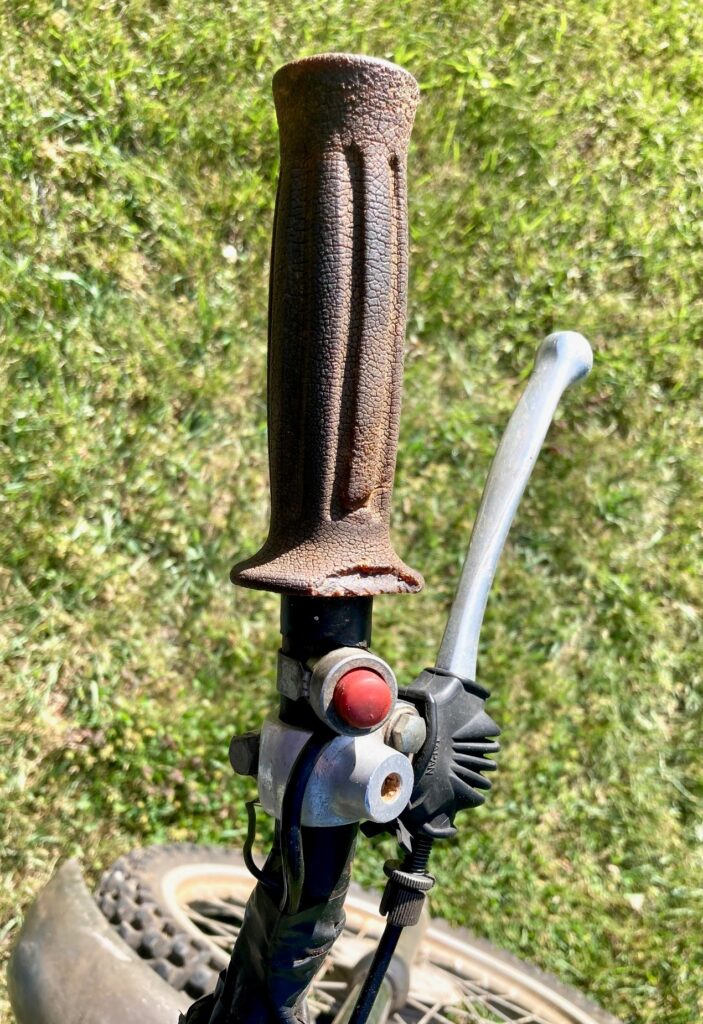
Little things can matter: the kill switch—which looks to be just standard 1970s-fare to my as yet non-Hodaka-acclimated mind—is present and won’t require the “super-rare” replacement Hodaka friends have already mentioned. The clutch lever assembly is likewise OEM Hodaka. The front brake lever is…something else…and we’re not yet sure about the throttle. The left grip is rather funky and will go into the vintage handgrip collection. Of course, the cables will all be replaced with shiny, functional units.
That’s enough for now! Our Combat, after the payment of $500 to the estate, has come home with us and is warm & dry, and making friends with all the other motorcycles in the garage. Once we start digging into disassembly, we’ll be back with an update.

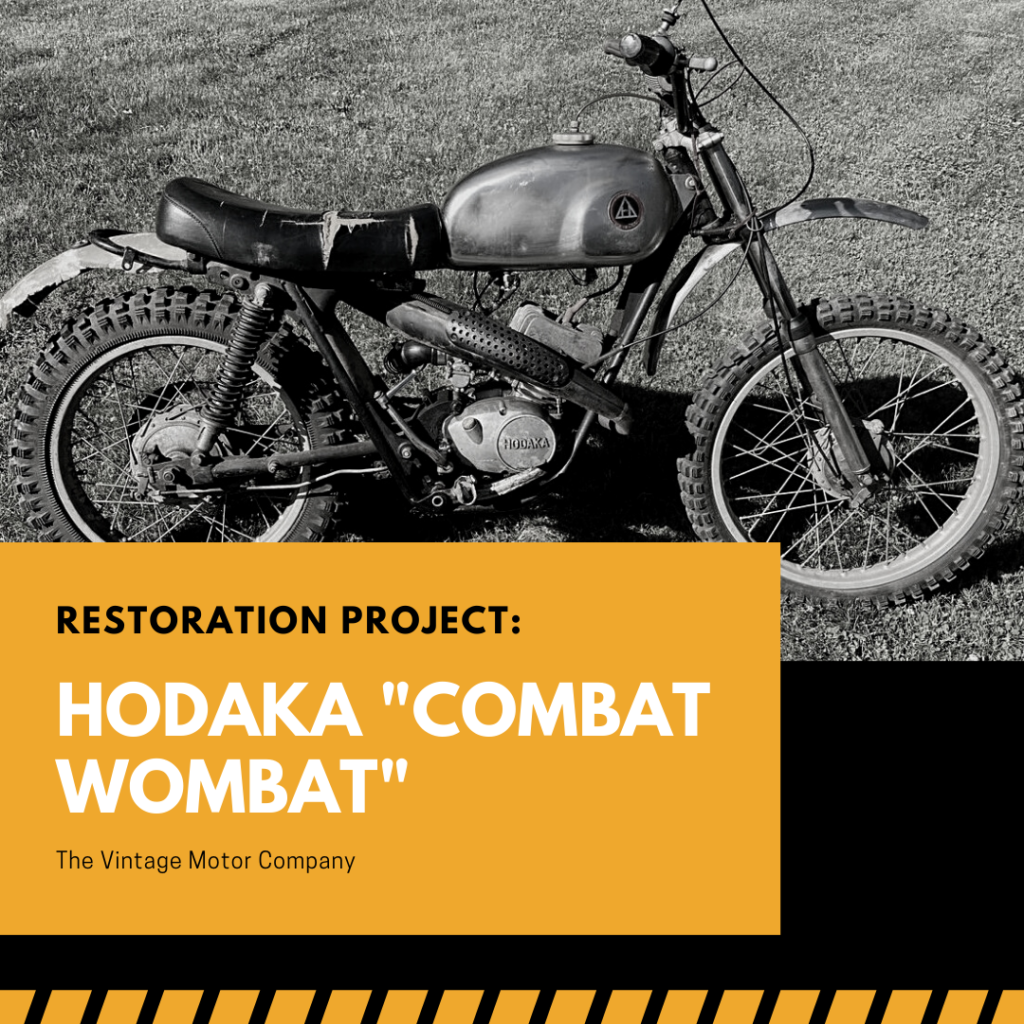
Do you have an update on your Combat restore? I’ve got one I just completed restoring for AHRMA VMX competition. Working on a Hodaka 175 restore also. Have a 250 and two dirt squirts that are restored /running bikes. Love the Hodaka’s!
Robert & Donna–thanks for the note! A husband & wife restoration team? Excellent!! We’ll get back to the Hodie; I confess I got sidelined completing a ’75 Maico 125, and then was caught up in our pile-of-Rickman/Montesa (deciding that after about 20 years, something had to be done!). One more thing has slowed us a bit: at our first AACA Museum (Hershey, PA) show this summer, what should show up but a PERFECT Combat Wombat? Now, nothing wrong with that, but it made pause a little. Essentially, it caused me to think, “OK, after a whole lot of money and time, you will have exactly this! What I’m attempting (poorly) to say is that a little of the ‘magic’ of the evolving restoration evaporated, temporarily. I recall my first bike restoration–a ’70 BSA 441–and I could find NO color picture of what one looked like (though at least one did exist–on the cover of the Haynes manual that I didn’t know existed!). It was utterly an archaeological experience–discovering a flick of paint here; a scribed paint-line, there. Not like today, when we can press a key and see exactly what our labor (and dollars) are going to produce. Not that we won’t complete it–we will. I just need to ‘forget’ that perfect bike a bit longer…so as to maximize the pleasure (and discovery process) of digging into the Combat! (Note: for the sake of honesty, I was still pondering one thing: To fix/chrome the existing tank, or buy the Indian repro. Any suggestions from the experts?)
Is the Indian repro tank compatible with the Hodaka cap?
Picture of the Indian tank show some sort of elevated filler neck and bulbous chrome cap.
Darrell–I don’t THINK it is, but I’ve never seen one in person. I keep mentioning the “chrome tank problem” to the Hodaka guys, but there doesn’t seem to be a reasonably economic way out. (Pardon me, but for some reason getting into $900-1000 for tank repair & chroming just seems a bit over-the-top to me.